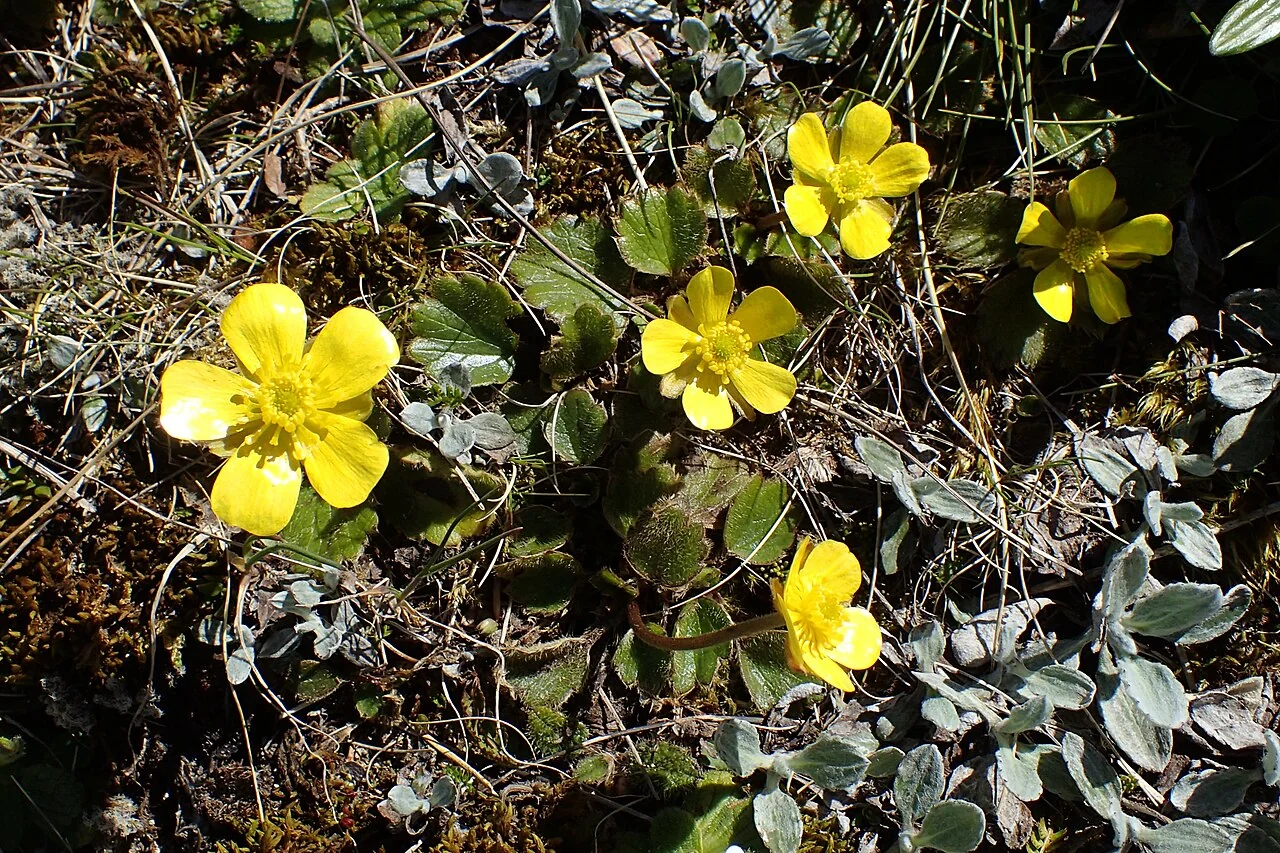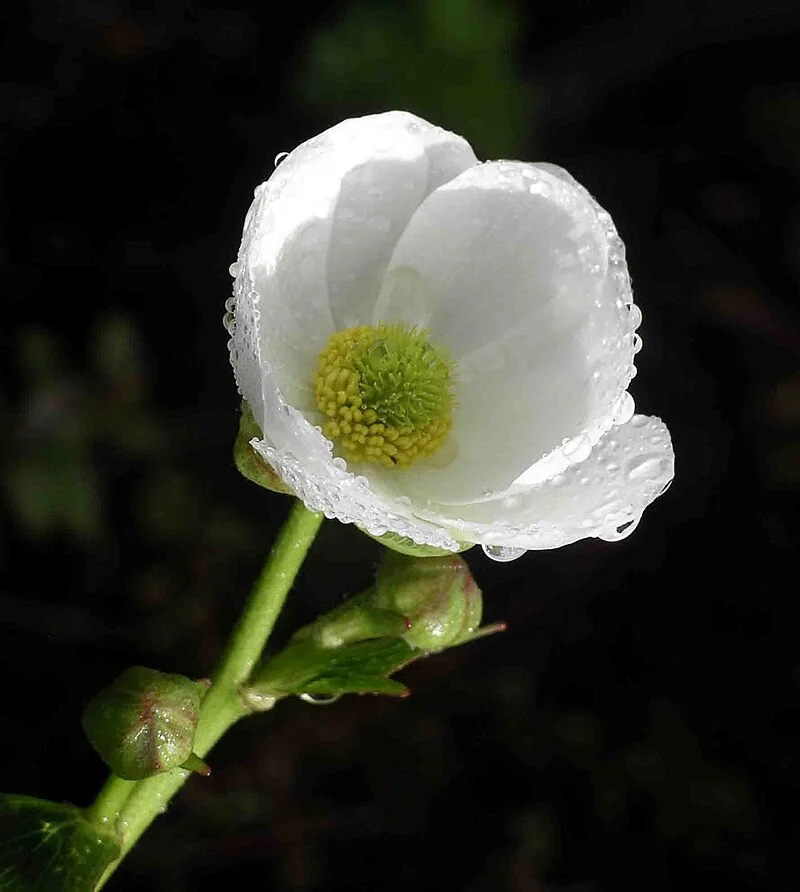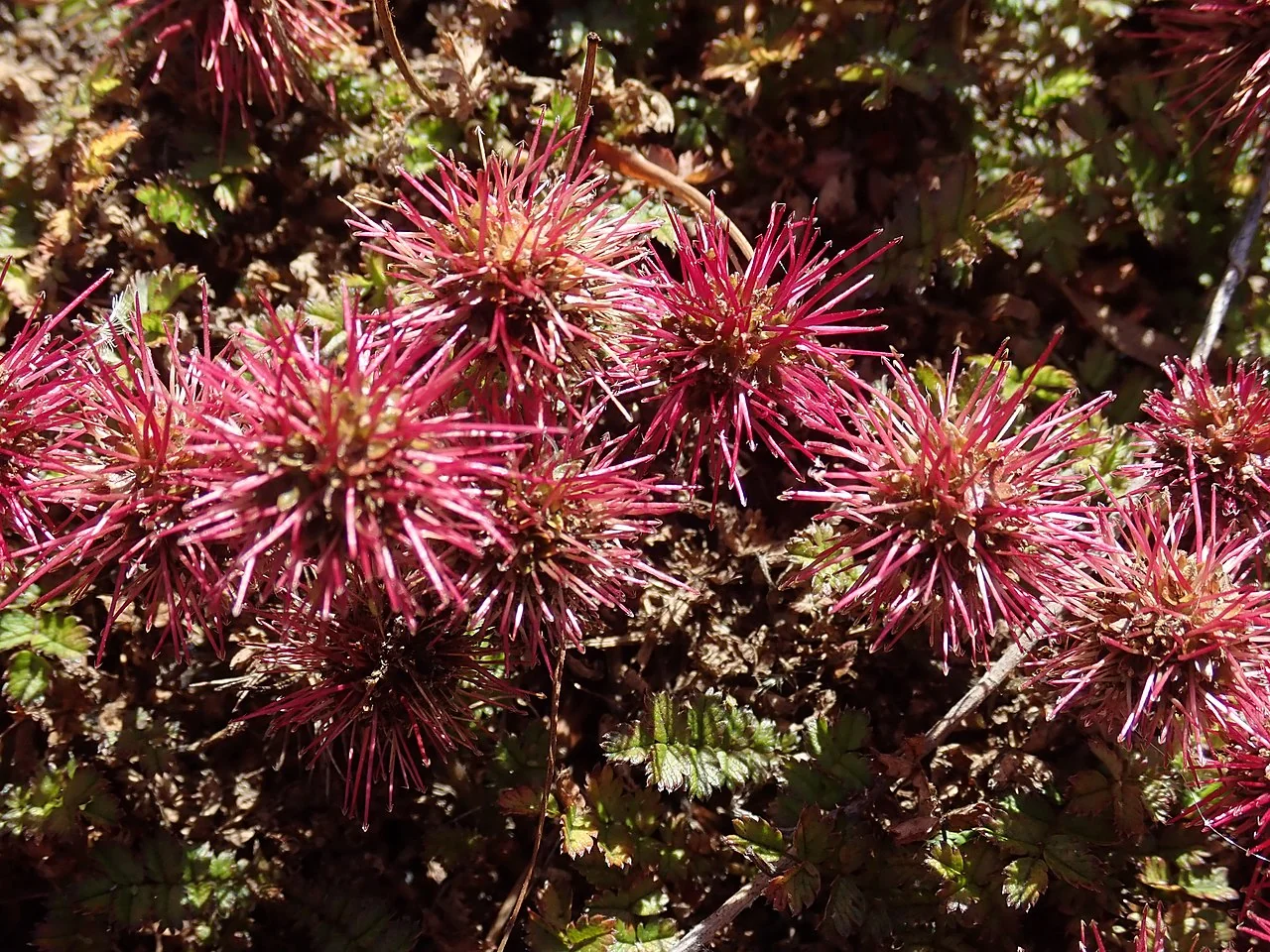
Ranunculus Insignis
Ranunculus insignis
Explore more NZ native plant guides in our index .
Giant Mountain Buttercup ( Ranunculus insignis ) stands as one of New Zealand's most spectacular and iconic alpine plants , creating breathtaking displays of enormous golden buttercup flowers that can span up to 5cm across, making it the largest buttercup in the country and a true jewel of the high country. This remarkable perennial herb represents the ultimate alpine adaptation, thriving in the harsh conditions of New Zealand's mountainous regions from 900-1800 meters elevation, where it has evolved extraordinary features to survive extreme cold, intense UV radiation, and powerful alpine winds. The plant's most striking characteristic lies in its impressive flowers - brilliant golden-yellow blooms with a lustrous, almost waxy appearance that shine like beacons against the often barren alpine landscapes, attracting the few hardy insects capable of surviving at such altitudes while providing crucial early-season nectar sources. The species demonstrates fascinating seasonal adaptations, with its large, glossy buttercup leaves emerging in spring to form distinctive rosettes that efficiently capture the brief but intense growing season sunlight, while its deep taproot system anchors the plant securely in rocky soils and accesses moisture reserves during dry periods. Found naturally in rocky alpine areas, scree slopes, and fellfield environments throughout New Zealand's South Island mountains, Giant Mountain Buttercup often grows alongside other alpine specialists like Mount Cook lily and mountain daisies, creating spectacular wildflower displays that attract botanists and nature photographers from around the world. The plant's cultural significance extends beyond its beauty, as it serves as an indicator species for healthy alpine ecosystems and represents the remarkable evolutionary adaptations that have allowed New Zealand's flora to colonize some of the planet's most challenging environments. In cultivation, this species requires very specific alpine conditions with excellent drainage, cool temperatures, and strong light, making it unsuitable for lowland gardens but highly prized by specialist alpine plant enthusiasts who can provide appropriate rock garden or alpine house conditions.
For alpine context, see alpine plants .

Plant Description
Botanical Features
Ranunculus Insignis , commonly known as the Giant Mountain Buttercup or Insignia Buttercup, is a spectacular and iconic alpine plant native to New Zealand. It is found in subalpine to low alpine regions of both the North and South Islands, typically at elevations between 700 and 1800 meters, though it can occur almost down to sea level in some areas like the Kaikoura coast. This perennial herb grows in clumps, varying in size from a robust herb 50-90 cm tall to a smaller tufted plant around 10 cm tall. It can spread up to 12 inches wide and is semi-evergreen. The leaves are a distinctive feature, often large, dark green, thick, and leathery. They can be heart- or kidney-shaped, ovate to lanceolate, with toothed or crenate margins. Larger forms can have leaves 15-22 cm in diameter, while smaller forms may have leaves only 2-4 cm in diameter. The undersides of the leaves often have brown hairs, or they can be villous (hairy) at least beneath. It produces numerous bright, glistening golden-yellow flowers that are among the largest buttercup flowers in New Zealand, spanning up to 5 cm across. These somewhat cup-shaped flowers typically have five to seven petals, but can have up to 12 or even 16 petals in some areas. They bloom from late spring to early summer, specifically from October to December in New Zealand. The flowering stems can be branched, carrying multiple flowers, or unbranched with a single flower in smaller forms.
Quick Facts
| Scientific Name | Ranunculus Insignis |
|---|---|
| Height | 0.5-1 m |
| Spread | 0.3-0.5 m |
| Water Needs | High |
| Light | Full sun to part shade |
| Frost Tolerance | High |
| Salt Tolerance | Low |
| Growth Rate | Medium |
| Lifespan | Perennial |
Climate Best Suited to
Ranunculus Insignis is typically found in alpine and subalpine areas of New Zealand, thriving in moist, well-drained soils. It prefers cooler climates and can tolerate frost. Its natural habitat includes damp grasslands, stream banks, and open rocky areas.
Regional Suitability
| Whangārei | Ideal |
| Auckland | Ideal |
| Hamilton | Suitable |
| Rotorua | Suitable |
| Tauranga | Ideal |
| Gisborne | Ideal |
| New Plymouth | Ideal |
| Whanganui | Ideal |
| Palmerston North | Suitable |
| Napier | Ideal |
| Wellington | Ideal |
| Nelson | Ideal |
| Christchurch | Suitable |
| Dunedin | Suitable |
| Invercargill | Suitable |
| City | Climate Suitability |
|---|
Natural Habitat
Giant Mountain Buttercup ( Ranunculus insignis ) is a spectacular alpine plant native to New Zealand. It is typically found in alpine and subalpine regions, thriving in moist, well-drained soils and preferring cooler climates where it can tolerate frost.
Key Habitats Include:
- Geographic Distribution: It is found in the central and eastern North Island mountains (from Mount Hikurangi southwards) and the South Island (from Nelson and Marlborough to about mid-Canterbury, and as far south as the Two Thumb Range). Interestingly, along parts of the Kaikoura coast, it can occur almost down to sea level, showcasing its adaptability. A new, isolated location has also been described in Westland.
- Specific Environments: Its preferred environments include damp grasslands, stream banks, open rocky areas, sheltered bluffs, rock outcrops, herbfields, and subalpine shrublands. In the South Island, it favors steep rocky cliffs and sheltered scrubland, often with a southerly aspect.
- Altitude: It typically grows at elevations between 700 and 1800 meters above sea level.
Preferred Conditions:
- Soil: It thrives in moist, well-drained soils, often in association with other alpine specialists like Mount Cook lily and mountain daisies.
- Climate: It is well-adapted to harsh alpine conditions, including extreme cold, intense UV radiation, and powerful alpine winds.
Ranunculus insignis is an indicator species for healthy alpine ecosystems, and its presence underscores its ecological importance in contributing to the biodiversity and stability of New Zealand's unique mountainous regions.
Plant Conservation
Ranunculus insignis , also known as the Giant Mountain Buttercup or Hairy Alpine Buttercup, is a plant native and endemic to New Zealand. According to the New Zealand Threat Classification System, its current conservation status is "Not Threatened." This status has been consistently maintained across assessments from 2004 to 2023. This perennial herb is found in the alpine and subalpine regions of New Zealand, thriving in moist, well-drained soils and cooler climates. It contributes to the local ecosystem by providing nectar and pollen for native insects.
Growing Requirements
Soil Requirements
Ranunculus Insignis thrives in moist, well-drained soils rich in organic matter. It prefers a slightly acidic to neutral pH. Good drainage is essential to prevent waterlogging, which can lead to root rot.
- Prefers moist, well-drained soil
- Rich in organic matter
- Slightly acidic to neutral pH
- Avoid heavy clay soils
Light Requirements
Ranunculus Insignis prefers full sun to part shade. In hotter climates, some afternoon shade can be beneficial to prevent scorching.
- Full sun for optimal flowering
- Tolerates partial shade
- At least 4-6 hours of direct sunlight daily is ideal
Water Requirements
Ranunculus Insignis requires consistently moist soil, especially during its growing season. It is not drought-tolerant and will suffer if the soil dries out.
- Keep soil consistently moist
- Water regularly, especially during dry periods
- Do not allow soil to dry out completely
- Reduce watering slightly in winter
Planting Guide
When to Plant
The ideal time to plant Ranunculus Insignis is during spring or autumn when temperatures are moderate.
Site Selection
Choose a site with:
- Full sun to partial shade
- Moist, well-drained soil rich in organic matter
- Protection from strong winds
Planting Procedure
- Dig a hole twice as wide and the same depth as the root ball
- Amend soil with compost or well-rotted manure
- Position the plant so the crown sits at soil level
- Backfill with soil, gently firming down
- Water thoroughly immediately after planting
- Apply a layer of organic mulch
Initial Care
Water regularly during the first growing season to ensure proper establishment.
Ecological Role
Ecosystem Roles
The ecological importance of Ranunculus Insignis within its native ecosystem is significant. This section explores its role in supporting biodiversity, its interactions with local wildlife, and its contribution to the overall ecological balance of its habitat.
- Contribution to local biodiversity.
- Interactions with native fauna (e.g., insects).
- Role in alpine ecosystem health and stability.
Uses and Significance
Garden Uses
- Ranunculus insignis is ideal for specialist alpine gardens and rockeries, creating stunning displays with its large golden flowers that mimic its high-country habitat.
- It is also highly suitable for damp borders and along stream banks, provided excellent drainage is maintained around its crown, adding a vibrant splash of colour.
- This impressive buttercup truly adds vibrant, eye-catching colour to the garden, especially when contrasted with other alpine flora in a well-designed setting.
Cultural Significance
Traditional Uses and Values
Ranunculus insignis , known by the Māori name korikori, holds significant cultural importance as one of the most distinctive alpine plants recognized in traditional Māori ecological knowledge. Māori were the first alpine botanists in New Zealand, and korikori was valued not only for its spectacular appearance but also as an environmental indicator of specific alpine conditions and seasonal changes. Found from East Cape to Kaikoura, this massive buttercup with its distinctive white flowers served as a landmark species that helped guide navigation and understanding of high-altitude environments. The plant's presence indicated healthy alpine ecosystems and demonstrated the remarkable adaptations of New Zealand's endemic flora to harsh mountainous conditions. Today, korikori continues to symbolize the unique evolutionary heritage of New Zealand's alpine regions and represents the deep connection between Māori traditional knowledge and contemporary conservation efforts in protecting these specialized high-altitude environments.
Landscaping Applications
Discover how Ranunculus Insignis can be effectively integrated into various landscaping designs. This section offers creative ideas and practical advice for using this plant to enhance the beauty and functionality of your outdoor spaces, from alpine gardens to damp borders.
- Design ideas for alpine and rock gardens.
- Best uses in various landscape settings.
- Combining with other plants for aesthetic appeal.
Seasonal Care Calendar
Spring
In spring, Ranunculus Insignis emerges from dormancy. Ensure consistent moisture and protect new growth from late frosts.
- New growth appears
- Ensure consistent moisture
- Protect from late frosts
Summer
Summer is the main flowering season for Ranunculus Insignis . Keep the soil consistently moist and deadhead spent flowers to encourage more blooms.
- Main flowering season
- Maintain consistent soil moisture
- Deadhead spent flowers
Autumn
During autumn, Ranunculus Insignis begins to prepare for winter dormancy. Reduce watering as temperatures drop.
- Foliage may start to die back
- Reduce watering
- Prepare for winter dormancy
Winter
Winter is the dormant period for Ranunculus Insignis . Minimal care is required. Ensure good drainage to prevent root rot in wet conditions.
- Dormant period
- Ensure good drainage
- Protect from extreme cold if necessary
When to Prune and How Much
Ranunculus Insignis generally requires minimal pruning. Remove spent flower stalks and any yellowing or damaged leaves to maintain a tidy appearance.
- Remove spent flower stalks after blooming
- Trim any yellowing or damaged leaves
- No heavy pruning required
Always use clean, sharp tools for pruning.
How to Grow Ranunculus Insignis
Ranunculus Insignis , also known as the Giant Mountain Buttercup, is one of New Zealand's most spectacular alpine plants, renowned for its enormous golden flowers. This remarkable perennial herb thrives in the harsh conditions of mountainous regions, making it a prized specimen for specialist alpine gardeners. While challenging to cultivate outside its native environment, understanding its propagation methods is crucial for those dedicated to growing this magnificent species.
From Seed
Propagating Ranunculus Insignis from seed can be challenging and requires patience, as germination can be slow and erratic. Collect ripe seeds in late summer or early autumn when they are fully mature. Sow the seeds fresh in a well-draining, sterile seed-raising mix, such as a blend of sand and fine grit. Lightly cover the seeds with fine medium. The seeds often benefit from a period of cold stratification (e.g., refrigerating seeds in moist sand for 8-12 weeks) to break dormancy. Maintain consistent moisture in the seed tray and keep it in a cool, sheltered location with bright, indirect light. Germination can take several months, and success rates can be variable. Once seedlings have developed a few true leaves and are stable, carefully prick them out into individual small pots, minimizing root disturbance. Grow them on in a sheltered environment with steady moisture before gradually hardening them off for planting out.
By Division
Division of mature plants is a more reliable method for propagating Ranunculus Insignis, particularly for established clumps. This is best undertaken in early spring or autumn when the plant is not actively flowering or setting seed. Carefully dig up the entire plant, ensuring minimal disturbance to the root ball. Gently separate the root ball into sections, making sure each division has a healthy portion of roots and at least one growing crown. Replant the divisions immediately at the same depth as the original plant into prepared soil that is well-drained and rich in organic matter. Water thoroughly after replanting to settle the soil around the roots and keep the divisions evenly moist until new growth indicates successful establishment. This method is effective for expanding existing plantings or for rejuvenating older, less vigorous clumps.
Pests and Diseases
Ranunculus Insignis is generally hardy, but can be susceptible to certain issues.
Common Pests
- Slugs and snails may feed on young foliage.
- Aphids can occasionally infest new growth.
Common Diseases
- Root rot can occur in poorly drained or waterlogged soils.
- Powdery mildew may appear in humid conditions with poor air circulation.
Environmental Stressors
- Drought Stress: Lack of consistent moisture will cause wilting and decline.
- Heat Stress: In hot climates, plants may struggle without adequate shade and moisture.
Ensure good cultural practices, such as proper watering and drainage, to minimize pest and disease problems.
Bonus Tip
Expert Growing Advice
For long-lived clumps of Ranunculus insignis , mimic alpine scree: plant in a sharply drained, gritty mix with cool root run and constant but never stagnant moisture in spring. A light top-dressing of fine gravel each autumn keeps crowns clean and reduces winter rot.







